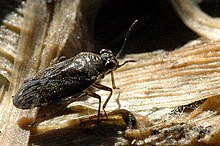Leptopodomorpha is an infraorder of insects in the order Hemiptera (true bugs). Leptopodomorpha is an infraorder of the order Heteroptera that contains more than 380 species. These small insects are also called shore bugs, or spiny shore bugs. As their name suggests, shore bugs range from being intertidal, to living near streams and lakes. Four families belong to this infraorder, the largest of which is Saldidae with about 350 species, compared to about 30 in Leptopodidae, and only 5 and 1 in Omaniidae and Aepophilidae respectively.[1] Saldidae are known in particular for their jumping ability.
| Shore bugs and allies | |
|---|---|

| |
| Saldula palustris | |
| Scientific classification | |
| Domain: | Eukaryota |
| Kingdom: | Animalia |
| Phylum: | Arthropoda |
| Class: | Insecta |
| Superorder: | Condylognatha |
| Order: | Hemiptera |
| Suborder: | Heteroptera |
| Infraorder: | Leptopodomorpha |
Families
edit- Aepophilidae Puton, 1879
- monotypic Aepophilus bonnairei Signoret, 1879
- Leptopodidae- spiny shore bugs
- Omaniidae
- Corallocoris Cobben, 1970 – SE Asia, Australia, Oceania, Japan
- Omania: includes Omania coleoptrata Horváth, 1915 - Oman
- Saldidae- shore bugs
Leptopodomorpha amber fossils were found in the Dominican Republic and Mexico, both dating back to the Miocene period.[citation needed] Fossils of Jurassic Archegocimicidae and Cretaceous Enicocorinae have also been found, and are presumed to be Leptopodomorpha.[citation needed]
References
edit- ^ J.H. Thorp; D.C. Rogers, eds. (2015). Thorp and Covich's Freshwater Invertebrates: Ecology and General Biology. Vol. 1 (4 ed.). Elsevier. pp. 954–955. ISBN 978-0-12-385026-3.